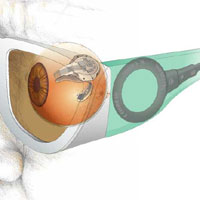
The company Intelligent Medical Implants has announced a limited clinical study where previously blind patients were able to discern light and simple patterns. Here's briefly how it works.
signal-processing functions of a healthy retina and provides input to
the retinal nerve cells that, in turn, provide
input to the optic nerve and the brain. The System comprises three main
components: (1) an implant, "The Retinal Stimulator", which is
surgically placed into the eye of a patient, who wears (2) a pair of
spectacles containing an integrated mini-camera and transmitter
components for wireless signal and energy transmission ("The Visual
Interface"). Via a cable, the spectacles are connected to (3) "The
Pocket Processor" worn at the patient's waist. This device replaces the
information processing function of the formally healthy retina. The use
of a high-speed digital signal processor allows the provision of
"intelligent information" to the implant (and the nerve cells) by using
tunable software to approximate the information processing normally
carried out by the healthy retina. The entire process enables patients
to optimize their visual perception during the learning phase. Indeed,
using the patient's feedback on perception as an input for the tuning
of The Pocket Processor is the unique, patent-protected feature of the
System and constitutes the 'learning' capability of the Learning
Retinal Implant System.
The initial indication for use is for blind persons with Retinitis Pigmentosa, which is one of the two most common causes of vision loss in persons over the age of 50. Several million people are affected worldwide.
IMI is developing a "neuro-prosthetics technology platform" of which this vision application is the first implementation. The company is based in Zug Switzerland, with offices in Germany.


Recent Comments